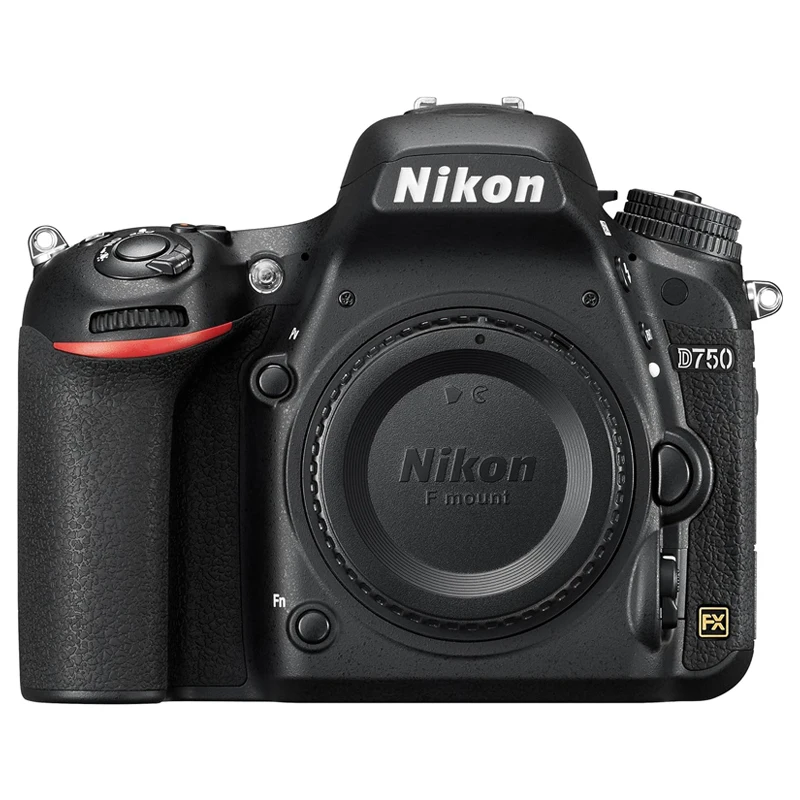



Loading message...
For video content, product variations, and additional details, visit the product page:
No video found for this product.




 FX format and approximately 24.32 million pixels combined to achieve stronger operability
FX format and approximately 24.32 million pixels combined to achieve stronger operability
The D750 provides an operating handle with a deep groove design to increase grip. This operability complements the imaging potential of approximately 24.32 million pixel resolution, giving users more freedom in actual shooting. The camera can shoot continuously at a speed of approximately 6.5 frames per second*1, and can take up to approximately 100 JPEG photos*2 at one time in both FX and DX formats, enhancing your ability to capture moving moments.
*1Based on the Japan International Camera and Imaging Equipment Industry Association (CIPA) standards.
*2Excluding JPEG fine/large size settings in FX format (approx. 87 pictures).
Compact body, expanded shooting potential
The D750 is a Nikon FX format model with a monocoque structure. The back cover and top cover are made of magnesium alloy, and the front body and front cover are made of carbon fiber composite material, resulting in a strong, lightweight construction. A slim design is achieved by placing the image sensor on the same plane as the integrated circuit board, which is approximately 70% the size of conventional designs (approximately 50% of the space is allocated to electronic components). Its position has been corrected and optimized to create the required space for the extension groove design of the operating handle, making it suitable for adding built-in flash, animation recording and other functions.
Reliable grip handle provides maneuverability
The camera is constructed so that you can hold the camera comfortably. The rounded design allows you to hold it comfortably. The material used in the D750 operating handle is synthetic leather, which is also used in the D4S and D810, while the memory card slot cover on the handle is made of rubber material to achieve a comfortable grip.
51-point AF system improves focus detection performance in dark light environments
The proven 51-point AF system of the D4S and D810 has now been further improved. The D750's 51 focus points form a high-density network that fully covers the center of the frame to achieve good subject capture. The 15 cross-type sensors are carefully arranged for rapid phase detection in both vertical and horizontal directions. All focus points respond at f/5.6 aperture. The Multi-CAM 3500 II autofocus sensor module provides powerful focus detection capabilities. Thanks to smooth, reliable AF performance in all brightness ranges, including dim environments. This shooting freedom is further extended by combining high ISO performance with AF capabilities in low-light environments.
AF shooting is possible even when the effective aperture is f/8
The 15 focus points (9 points in the center and 3 points on each side) are compatible with apertures slower than f/5.6 and faster than f/8. At the same time, 11 points are also compatible with apertures of f/8. This allows you to focus smoothly when using a 1.4x or 1.7x teleconverter, and even when a telephoto NIKKOR lens is combined with a 2.0x teleconverter such that the effective aperture is f/8. When the D750 body is paired with FX-format lenses and teleconverters, the mobility achieved by the system will bring more shooting opportunities.
Focusing is faster and more reliable: Group area AF quickly locks on moving targets
In addition to single-point AF, dynamic area AF, 3D tracking and auto-area AF modes, the D750 also uses the same group-area AF mode as the D4S and D810. Dynamic area AF uses only one initial AF point, while group area AF can use five AF points simultaneously like a mesh. This allows you to focus sharply on even unpredictable moving subjects while avoiding misfocusing on the background.
Three image area options change your perspective
The D750 provides 3 image area options for shooting still images: [FX (36 × 24) 1.0×] corresponds to the FX format (35.9 × 24.0 mm), providing an angle of view equivalent to a 35mm format camera; [1.2× (30 × 20) 1.2 ×] provides a size of 29.9 × 19.9 mm; [DX (24 × 16) 1.5×] corresponds to the DX format (23.5 × 15.7 mm). The actual angle of view is equivalent to about 1.2 times or 1.5 times the focal length of the lens. Providing both FX and DX options in the camera, coupled with a large zoom lens, allows you to use a portable system for flexible and dynamic shooting. Another great advantage of the DX format is that the 51 focus points cover almost the entire composition, making it easier to capture fast-moving subjects. When using a DX lens, the camera automatically selects [DX (24 × 16) 1.5×].